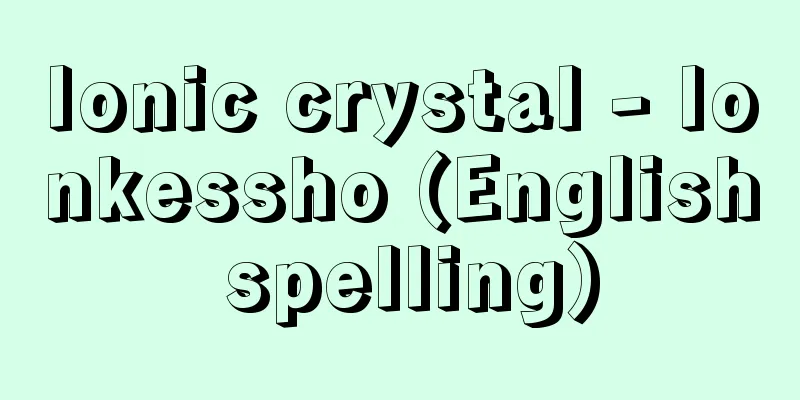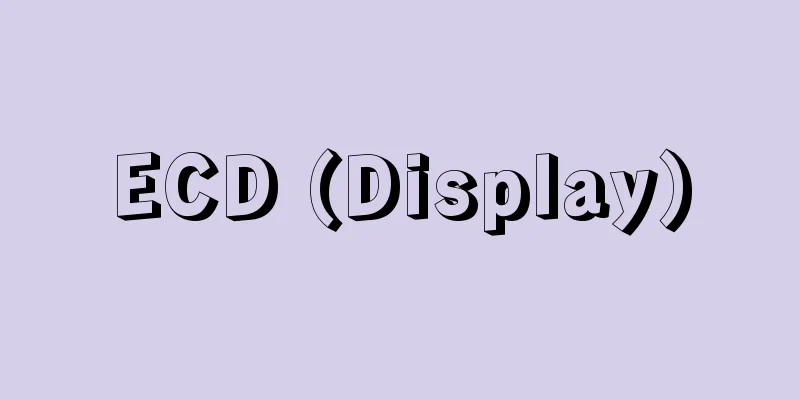Ionic crystal - Ionkessho (English spelling)

|
A crystal formed by cations and anions agglomerating due to electrostatic attraction and arranging in a regular three-dimensional manner. Known examples include monoatomic ion crystals such as sodium chloride (NaCl) and calcium fluoride (CaF 2 ), polyatomic ion crystals such as ammonium sulfate (NH 4 ) 2 SO 4 , and complex ion crystals such as potassium ferricyanide(III) (potassium ferricyanide, ferrocene) K 3 [Fe(CN) 6 ]. The arrangement of atoms (ions) and interatomic distances in these crystals can be measured by X-ray diffraction, neutron diffraction, nuclear magnetic resonance spectroscopy, etc. [Iwamoto Shinbu] Ionic Radius In a typical ionic crystal, the size of each ion is considered to be almost constant even if the combination of cations and anions is changed. Therefore, the crystal ionic radius is the value of the size of the ion expressed as the radius of the ion as a hard sphere. Separately, the radius of a gaseous ion can be calculated using quantum mechanics, but this value does not necessarily match the crystal ionic radius. The electrostatic attraction acting in an ionic crystal has no direction, and an ion tries to attract as many ions of the opposite sign as possible around it, and to attract them as close as possible. When an anion and a cation approach each other, the repulsive force between the electrons outside the nucleus increases, and the structure of the ionic crystal stabilizes when the attractive and repulsive forces reach equilibrium. At this time, the shortest distance between the two ions is the sum of the ionic radii of both ions. The ionic radius varies slightly depending on the crystal structure and coordination number (the number of ions of the opposite sign at the shortest distance), so it is calculated by dividing the shortest distance calculated for a combination of ions with the same electron configuration (Na + and F - , K + and Cl -, etc.) in inverse proportion to the effective nuclear charge of each ion. For example, in the case of K + and Cl - with an argon (Ar) type electron configuration, the shortest distance is 314 pm, and the effective nuclear charges are K + = 7.4 and Cl - = 5.4, so For homovalent ions in the same group on the periodic table, the ionic radius increases as the atomic number increases. [Iwamoto Shinbu] Radius Ratio LawIn ionic crystals, the positive and negative ions, which have different radii, try to form a structure in which they are packed together with as little space as possible. Therefore, the relationship between the cation radius r + and the anion radius r- and the ionic valence have a great influence on the structure. The rule that shows the relationship between the ratio of ionic radii r + / r- and the coordination number is called the radius ratio law. Generally, r + is often smaller than r- , so if we start from a state where the radius ratio is small, when the radius ratio is less than 0.155, only two anions can approach the cation. When it reaches 0.155, the coordination number becomes 3. When it reaches 0.225, the anion surrounds the cation in a regular tetrahedron, and the coordination number becomes 4. When it reaches 0.414, the cation is surrounded by the anions in a square shape, and two more anions are added from above and below, resulting in a regular octahedral structure with a coordination number of 6. When it reaches 0.732, it becomes a cube with 8 coordinations, and when it reaches 1, it becomes a close-packed structure. If the cubic 8-coordination is maintained, then the structure with a radius ratio of 1 is similar to a body-centered cubic structure. [Iwamoto Shinbu] Structure of ionic crystalsA typical ionic crystal has a coordination structure according to the radius ratio law. In sodium chloride, with a radius ratio of 0.525, the sodium ion fills the octahedral 6-coordinated gap in the face-centered cubic lattice formed by the chloride ions, but the sodium ion also forms a separate face-centered cubic lattice. In cesium chloride CsCl, with a radius ratio of 0.934, the crystal has a cubic 8-coordinated structure, and the cesium ion is surrounded by eight chloride ions. In this case, the cesium ion also forms a separate cubic lattice. In calcium fluoride, the radius ratio is calculated to be 0.728, but in reality, Ca 2+ is surrounded by eight F - ions in a cubic 8-coordinated structure. Ca 2+ forms a face-centered cubic lattice, and the structure appears to have F - ions in the tetrahedral 4-coordinated gap of the face-centered cubic lattice. These F - ions form a simple cubic lattice. Even in typical ionic crystals, some covalent bonding is observed, and ionic crystals in which the contribution of covalent bonding is large often have two-dimensional layered structures or one-dimensional chain structures. [Iwamoto Shinbu] Properties of Ionic CrystalsIonic crystals are generally insulators, but impurities and lattice defects can make them semiconductors, and at high temperatures they can become ionic conductors. When melted into a liquid, they are conductive. Crystals with short interionic distances and high valences are generally hard and have high melting points. The melts of ionic crystals are called molten salts or fused salts, and are used as conductive solvents or high-temperature solvents, as in the case of cryolite Na 3 [AlF 6 ], which is used in the electrolytic refining of aluminum. Ionic crystals with impurities and lattice defects can have characteristic colors, or exhibit fluorescence or phosphorescence. Rubies and sapphires are red or blue due to traces of impurity ions in the normally colorless aluminum oxide crystals (corundum). [Iwamoto Shinbu] "Ionic Crystals" by N. N. Greenwood, translated by Tsuneo Sato and Shigeru Tamaki (1974, Baifukan) [References] | | [Supplementary information] |©Shogakukan "> Ionic Radius ©Shogakukan "> Radius Ratio Law ©Shogakukan "> Examples of ionic crystal structures Source: Shogakukan Encyclopedia Nipponica About Encyclopedia Nipponica Information | Legend |
|
陽イオンと陰イオンとが静電引力によって凝集し、立体的に規則正しく配列してつくる結晶のこと。塩化ナトリウムNaCl、フッ化カルシウムCaF2のような単原子イオン結晶、硫酸アンモニウム(NH4)2SO4のような多原子イオンの結晶、ヘキサシアニド鉄(Ⅲ)酸カリウム(フェリシアン化カリウム、赤血塩)K3[Fe(CN)6]のような錯イオンの結晶などが知られている。これらにおける原子(イオン)の配列や原子間距離は、X線回折法、中性子線回折法、核磁気共鳴吸収分光法などによって測定される。 [岩本振武] イオン半径典型的なイオン結晶では、陽イオンと陰イオンの組合せを変えても、それぞれのイオンはほぼ一定の大きさであると考えられる。そこでイオンを剛体球とし、イオンの大きさをその半径で示した値が結晶イオン半径である。別に気体イオンを考えて、その半径を量子力学的に計算した値も得られるが、その値は結晶イオン半径とはかならずしも一致しない。イオン結晶で作用する静電引力は方向性がなく、あるイオンはなるべく数多くの反対符号イオンを周りに引き付け、しかもなるべく近く引き付けようとする。陰陽両イオンが接近すると核外電子間の反発力が大きくなり、引力と反発力が平衡に達したところでイオン結晶の構造が安定化する。このとき、両イオン間の最短距離が両イオンのイオン半径の和となる。イオン半径は、結晶構造や配位数(最短距離にある反対符号イオンの個数)によってやや異なるので、電子配置が同じになるイオンの組合せ(Na+とF-、K+とCl-など)で求めた最短距離をそれぞれのイオンの有効核電荷に逆配分比例で分割して求める。たとえばアルゴン(Ar)型電子配置をとるK+とCl-では、最短距離は314ピコメートル、有効核電荷はK+=7.4、Cl-=5.4となるので、 周期表で同族となる同価イオンでは、原子番号が大きくなるほどイオン半径も大きくなる。 [岩本振武] 半径比則イオン結晶では、互いに半径の異なる陰陽両イオンが、なるべくすきまを少なくするように詰め込まれた構造をとろうとする。したがって、陽イオン半径r+と陰イオン半径r-の大小関係とイオン価はその構造に大きな影響を及ぼす。イオン半径の比r+/r-と配位数との関係を示す規則を半径比則という。一般にr+はr-より小さくなることが多いので、半径比の小さい状態から考えていくと、半径比が0.155未満では、陽イオンの周りには2個の陰イオンしか接近できない。0.155に達すると配位数は3となる。0.225に達すると、陰イオンは陽イオンを正四面体的に取り囲み、配位数は4となる。0.414に達すると、陽イオンは陰イオンによって正方形型に取り囲まれるとともに、上下からさらに2個の陰イオンが加わり、結局、正八面体構造となって配位数は6となる。0.732になると立方体8配位となり、1になると最密充填(じゅうてん)構造になる。立方体8配位のままであれば、半径比1の構造は体心立方構造と同じようなものとなる。 [岩本振武] イオン結晶の構造典型的イオン結晶は半径比則に従った配位構造をとる。半径比0.525となる塩化ナトリウムでは、塩化物イオンのつくる面心立方格子中の八面体型6配位の空隙(くうげき)にナトリウムイオンが入るが、そのナトリウムイオンも別に面心立方格子をつくっている。半径比が0.934となる塩化セシウムCsClでは立方体型8配位構造をとって、セシウムイオンは8個の塩化物イオンに囲まれる。この場合もセシウムイオンは別に立方体格子をつくっている。フッ化カルシウムでは半径比は0.728と計算されるが、実際にはCa2+は8個のF-によって立方体型8配位で囲まれる。Ca2+は面心立方格子をつくっており、見かけ上、その面心立方格子の四面体型4配位の空隙にF-が入っているような構造となる。それらのF-は単純立方格子をつくっている。典型的イオン結晶においても、いくらかは共有結合性がみられ、共有結合性の寄与が大きくなったイオン結晶では二次元的層状構造や一次元的鎖状構造をとることが多い。 [岩本振武] イオン結晶の性質イオン結晶は一般に絶縁体であるが、不純物や格子欠陥のために半導体となったり、高温度でイオン導電体になることがある。融解して液体になれば導電性を示す。イオン間距離が短く、イオン価の大きい結晶は一般に硬く、融点も高い。イオン結晶の融体は融解塩または溶融塩とよばれ、アルミニウムの電解精錬に用いられる氷晶石Na3[AlF6]の例のように、導電性溶媒や高温溶媒として利用される。不純物や格子欠陥のあるイオン結晶には、特徴のある色彩や、蛍光性あるいはリン光性を示すものがある。ルビーやサファイアは、本来無色の酸化アルミニウムの結晶(コランダム)に含まれる微量の不純物イオンによって赤あるいは青色を呈している。 [岩本振武] 『N・N・グリーンウッド著、佐藤経郎・田巻繁共訳『イオン結晶』(1974・培風館)』 [参照項目] | | [補完資料] |©Shogakukan"> イオン半径 ©Shogakukan"> 半径比則 ©Shogakukan"> イオン結晶の構造例 出典 小学館 日本大百科全書(ニッポニカ)日本大百科全書(ニッポニカ)について 情報 | 凡例 |
<<: Ion exchange - ion exchange
Recommend
Myoho-in Temple
Located in Myoho-in Maekawa-cho, Higashiyama-ku, ...
Ugan - Ugan
...Sacred places similar to the mainland's sh...
double-hung
…The French window was developed in the 16th cent...
Illumination (manuscript painting) - Illumination
…Illustration, like illumination, is derived from...
Ceva's theorem
In triangle ABC, let P be a point different from ...
Mr. Abiru
…It is also notable that, despite its small size,...
Clapham - John Harold Clapham
British economic historian. He studied at Cambrid...
Buffalo (English spelling)
A commercial, industrial and transportation city i...
Commander-in-Chief of Oshu
…In August 1335 (Kenmu 2), immediately after the ...
waistcoat
…A short, sleeveless vest, also called a waistcoa...
Hidden Gate - Kugurimon
〘 noun 〙 A low, small gate made to be entered and ...
Ecewit, B. - Ecewit
...As the Demirel government was unable to handle...
Japan Housing Finance Agency
It is a financial institution established based o...
Prunus incisa (English spelling) Prunusincisa
…[Hiroshi Aramata]. … *Some of the terminology th...
Sesame spotted longhorn beetle - Sesame spotted longhorn beetle
It is an insect belonging to the family Cerambyci...









